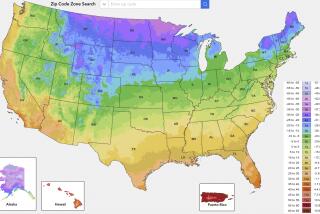Detective Work Helps Map Yard’s Highs, Lows
Finding out what microclimates you have in your yard will enable you to choose the right plants for each area. This can be done by keeping a number of things in mind:
* Know the layout of your house. Draw a diagram of your home and label each outer wall, suggests Vern Hee of Leaves of Grass Landscaping in Lake Forest.
Areas in front of western-facing walls will get full sun all day and will be very hot and harsh, unless there is the cooling effect of nearby trees.
Southern-facing wall areas also receive sun all day and are warm, but the sun and heat they get isn’t as harsh as in western areas. South-facing walls will also warm nearby plants at night and are great places to put heat-loving plants.
Areas of the yard where there are eastern-facing walls will get sun until about noon and then lose light, so put in plants that need only partial sun.
North-facing walls are your darkest and coldest areas. Use these parts of your yard for plants that like shade and cooler conditions, like many camellias and azaleas.
*Check for protected areas. Large structures such as overhangs and large trees provide shade and protection during cold nights, which creates microclimates that are perfect for growing certain plants. For example, a southern-facing wall with an overhang makes a great place to grow delicate tropical plants such as banana and mango trees that need lots of heat and protection from frost. Such areas are also good for growing heat-loving plants such as tomatoes in the winter.
*Consider white walls. White walls tend to reflect sun and heat surrounding plants. This can be useful if the plants are on a cooler side of the house, such as an eastern or northern exposure, but it can mean that plants on a western exposure next to a white wall could bake.
*Look for hills. If you have a hill in your landscape, chances are the bottom will get a lot of sun, which can lead to it drying out, especially if it has a western exposure. Consider this when setting up a watering schedule and choosing plants for the area.
*Use your lawn as a gauge. Brown areas in lawns generally indicate hot spots, Hee says. Once you’ve determined that the area is getting water, look around to see if there is a nearby white wall or a window or other fixture on the house reflecting heat to that area. To solve the problem, increase water to that spot. For a long-term solution, you may want to plant a tree in front of that section of the house.
*Investigate. One of the best ways to determine the microclimate of an area is to do your own field work. Several times during a day, stand in an area that you suspect may be a hot spot and feel if it is hotter, says Hee, who also suggests testing the soil with your hand to see if it’s dryer than surrounding soil.
Test cold, dark areas in the same way. The best time to feel an area at its coldest is January or February as close to dawn as possible, says Scott Lathrop, general manager of Flowerdale Nurseries in Santa Ana.
If you want to get really accurate, you can place an outdoor thermometer at the sites in question.
*Expect change. As surrounding trees grow or you cut them back, your microclimates will change. Adding structures such as patio coverings, trellises and arbors will also cause shifts in temperature.






